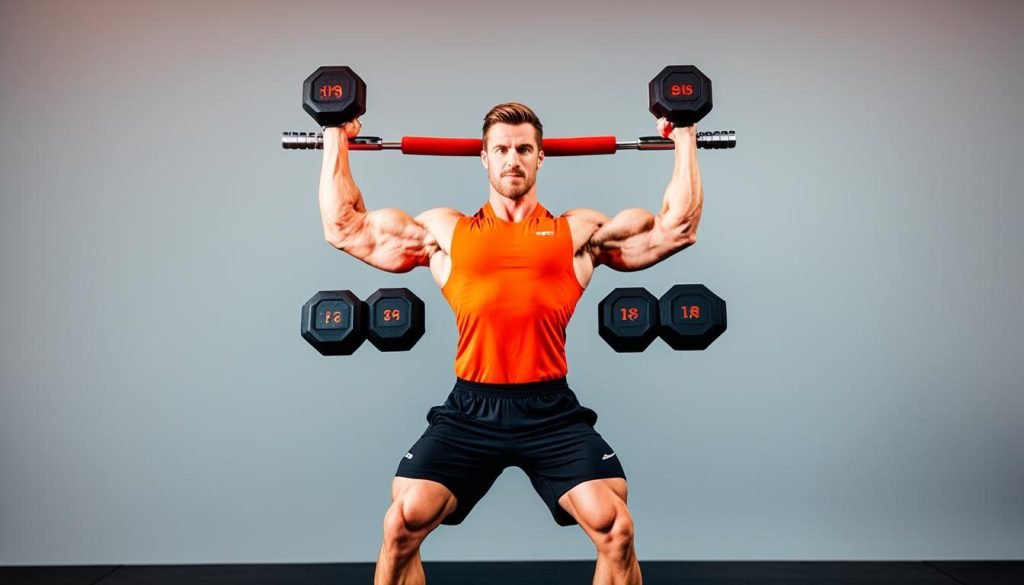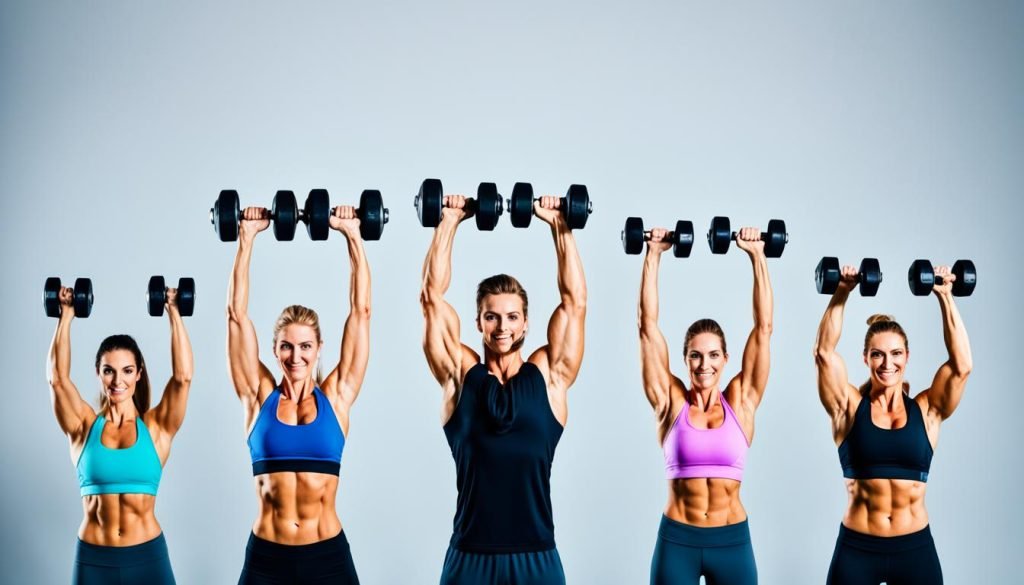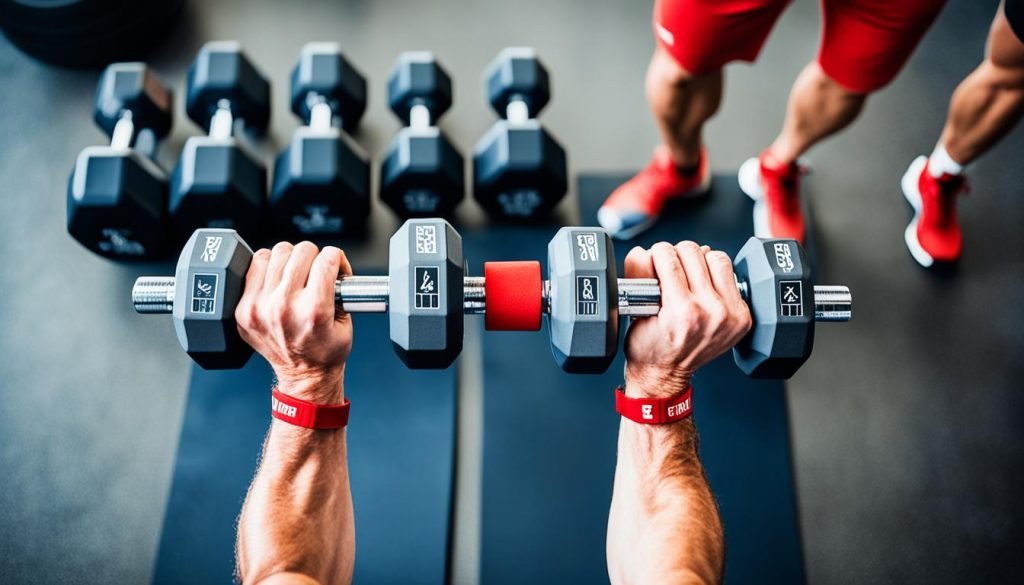Ever wondered why dumbbell rows are key for strength training fans? This exercise targets many muscles and boosts your back workout. It's perfect for those who want to build upper body strength easily. This guide will cover how to do it right, its benefits, and different ways to do it.
Key Takeaways
- Dumbbell rows are essential for upper body strength.
- They target various muscle groups, particularly the back.
- Improving your form can prevent injury and maximize results.
- Incorporating variations can keep your workouts engaging.
- Consistency in strength training can lead to muscle hypertrophy.
- Proper warm-up and cool-down techniques enhance performance.
What Are Dumbbell Rows?
Dumbbell rows are a favorite among those who want to strengthen their upper body. This exercise is great for working out many muscle groups and boosting strength. Knowing about dumbbell rows can help people on their fitness path.
Definition and Overview
This exercise involves bending at the hips and pulling a dumbbell towards the chest. It's all about focusing on proper form and precision. It's easy to do and doesn't need much gear. It's a key part of many workouts, helping to build muscles in the back and shoulders.
Muscle Groups Targeted
The main muscle groups worked in dumbbell rows are:
- Latissimus Dorsi: Important for a wider back.
- Rhomboids: Key for upper back strength and stability.
- Posterior Deltoids: Helps with shoulder movements and keeping posture right.
- Spinal Erectors: Needed for keeping the right posture during the exercise.
Doing this exercise regularly boosts upper body strength and helps achieve a balanced look. It works these key muscle groups, making it a solid base for lifting in different areas.
Benefits of Performing Dumbbell Rows
Dumbbell rows offer many benefits for fitness. They help improve strength, size, and how well you move. Adding this exercise to your routine can make a big difference.
Strengthening Back Muscles
Dumbbell rows are great for making back muscles stronger. They work on the lats, traps, and rhomboids. This leads to a stronger, more defined back, which is key for doing well in many activities.
Improving Muscle Hypertrophy
Dumbbell rows help grow muscles. The exercise puts tension on the muscles, causing them to grow bigger and stronger over time. They are a key part of any strength training plan.
Enhancing Posture
Dumbbell rows also help improve posture. They strengthen the upper and middle back, which helps keep the spine aligned. This leads to better posture and less back pain.
Unilateral Training Advantages
Training with one side at a time has many benefits, especially for balancing muscles. Dumbbell rows work on one side of the body, helping to prevent one side from getting too strong. This improves functional strength and helps prevent injuries.

Essential Tips for Perfecting Your Form
To get the most out of dumbbell rows, focus on details and perfecting your form. It's key to correct common mistakes to boost performance and lower injury risk.
Common Mistakes to Avoid
When improving your technique, spot and dodge common mistakes that slow you down. These include:
- Using weights that are too heavy: This can lead to improper shoulder blade retraction, straining your back.
- Poor body alignment: Not keeping your spine neutral can mess up your form and effectiveness.
- Rushing the movement: Doing the exercise too fast can cut down on muscle group engagement.
Warm-Up and Cool-Down Techniques
Effective warm-up and cool-down routines are key for a solid workout. A good warm-up gets your muscles and joints ready for strength training. Here's what to do:
- Dynamic stretching: Spend five to ten minutes doing arm circles and torso twists.
After your workout, cool-down techniques help with recovery and prevent soreness:
- Static stretching: Hold stretches that focus on the back and shoulders to ease tension.
Sticking to these practices boosts your performance and helps you master form.
Dumbbell Row Variations to Try
Trying out different dumbbell row exercises can make your workout better and hit various muscles. Each type has its own goal, fitting your fitness aims and likes.
One-Arm Dumbbell Row
The one-arm dumbbell row focuses on strengthening each side of the back separately. It helps balance muscle growth by working one arm at a time. This is great for fixing strength gaps, letting you work on weaker sides alone.
Bent-Over Dumbbell Row
The bent-over dumbbell row works both sides together, perfect for building back strength. It lets you lift heavier weights and keeps your back straight, promoting muscle growth.
Incline Bench Dumbbell Rows
Incline bench dumbbell rows support the spine well, focusing on back muscles. Using an incline bench helps you move more and protects your lower back. It's ideal for those aiming for muscle growth.
Couch Supported and Stability Ball Rows
Couch supported and stability ball rows test your core and back strength. They engage more muscles, making your workouts more challenging. Moving from easy couch rows to harder stability ball rows can boost your fitness level.

How to Incorporate Dumbbell Rows in Your Workout Routine
Adding dumbbell rows to your workout can boost strength and muscle growth. It's important to plan how often you do them and pair them with other exercises. This approach helps get the most out of your training.
Best Practices for Frequency and Progression
Try to do dumbbell rows two to three times a week. This helps muscles grow and allows for enough rest. Slowly increase the weight and intensity to keep improving. Keeping track of your progress makes the routine more exciting and motivating.
Combining with Other Exercises
Pairing dumbbell rows with other exercises makes your strength training complete. You can combine them with chest presses or shoulder exercises. This targets different muscles in your upper body. It balances strength and improves everyday activities.
- Chest Presses
- Shoulder Presses
- Pull-Ups
- Push-Ups
This mix of exercises boosts overall strength and makes your fitness plan more effective.

Common Concerns and Safety Precautions
When doing dumbbell rows, it's key to focus on safety precautions for a good workout. Keeping your back straight is a top priority. Wrong form can cause pain and harm. If you have back problems or health issues, talk to a doctor before starting dumbbell rows.

It's also important not to lift too heavy weights too fast. This can hurt your progress and health. Start with lighter weights and slowly add more as you get stronger. This way, you avoid getting hurt.
Keeping your spine neutral during the exercise is also crucial for safety and doing well. This helps avoid straining your lower back and improves your performance. Keeping these common concerns in mind makes your workout safer and more effective.
Conclusion
Mastering dumbbell rows is key for those wanting to boost their strength, especially in the upper body. This exercise works on several muscle groups. It helps with strength training and improves athletic performance.
Learning the basics of dumbbell rows and trying out different forms can help you add this exercise to your workout. Doing these rows regularly helps grow your muscles. It also helps improve your posture, which is important for your overall health.
Adding dumbbell rows to your workout plan can bring big benefits. It's a must-do for anyone looking to improve their strength training. This exercise can help unlock your upper body's full potential and lead to better physical results.
FAQ
What are dumbbell rows and how do they work?
Dumbbell rows are a key exercise for the upper body. You bend at the hips and pull a dumbbell towards your chest. This targets the back muscles, like the latissimus dorsi and rhomboids. It boosts upper body strength and muscle growth.
Why are dumbbell rows important for strength training?
Dumbbell rows are key for strengthening back muscles and improving posture. They also fix muscle imbalances with unilateral training. This builds a strong base for upper body strength, vital for weightlifting.
How can I ensure proper form while performing dumbbell rows?
Keep your back neutral and don't round your spine. Start with lighter weights to get the movement right. Focus on controlled lifts and lowerings. Engaging your core helps keep your body stable.
What are some common mistakes to avoid during dumbbell rows?
Avoid using too heavy weights, which can lead to bad form. Don't skip warming up before your workout. Also, avoid twisting your body during the exercise to prevent back strain.
Can I incorporate different variations of dumbbell rows into my workout?
Yes, try different variations like the one-arm dumbbell row, bent-over dumbbell row, incline bench rows, or stability ball rows. These can target various muscle groups and keep your workouts interesting while boosting upper body strength.
How often should I perform dumbbell rows in my training routine?
Do dumbbell rows two to three times a week. This helps stimulate muscles enough and allows for recovery. It also fits well with other exercises for a well-rounded upper body workout.
Are there any safety precautions to take when performing dumbbell rows?
Always start with a weight you can handle and increase it as you get stronger. Keep an eye on your back posture and warm up well to reduce injury risks.
Source Links
- Dumbbell Row: Muscles Worked, Proper Form, Variations & More | ISSA – https://www.issaonline.com/blog/post/dumbbell-row-muscles-worked-proper-form-variations-more
- Home Weight lifting Equipment Blog | Ironmaster – https://www.ironmaster.com/blog/ultimate-guide-to-dumbbell-rows/
- How to Do the Dumbbell Row—Plus Some Common Mistakes to Avoid – https://www.self.com/story/dumbbell-row
Recent Posts
It's important to evaluate whether Beachbody On Demand continues to meet your fitness needs as we enter 2025. With a range of workout programs and nutrition plans, the platform claims to cater to...
Just like having a personal trainer at your fingertips, Beachbody On Demand offers you an extensive library of on-demand workout programs accessible anytime, anywhere. This service allows you to...

